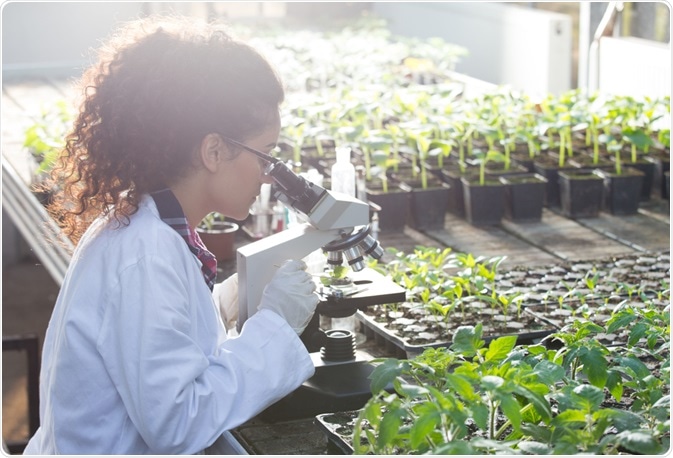The recent acceleration of technological innovations in biology has offered insights that are being increasingly implemented to address agricultural challenges. Such biotechnological advances provide key approaches to tackling modern and future issues from food security to environmental change.

Biotechnology in Agriculture. Image Credit: Budimir Jevtic/Shutterstock.com
Biotechnology in agricultural practices
Biotechnology can be defined as the discipline of applying biological processes to produce and manufacture products used in various facets of human life.
Modern biotechnology typically considers the natural processes of DNA replication, breakage, ligation, and repair. These have provided a better understanding of the mechanics of cell biology as well as their hereditary process and how these can be applied to disciplines including medicine, plant, and food science, and across agricultural practices.
Within agriculture, the principal goal of modern biotechnology is to improve the quality, quantity, nutrition, taste, and shelf life of produce, ultimately enabling stakeholders to obtain greater yield with reduced energetic costs. This includes agricultural processes dating from antiquity, including fermentation, and recent examples of developing disease-resistant plant varieties through crossbreeding.
To improve agricultural practices through biotechnological progress, modern methods include transgenic techniques, revolving around the insertion of foreign DNA strands into the host genome, to obtain enhanced crop yield. In 2004 alone, nearly 80 million hectares of land produced transgenic crops in countries including the USA, South America, China, Canada, and South Africa. The most sought-after target traits to improve crop yields in transgenic crops remain herbicide tolerance, virus and insect protection, tolerance to natural stressors.
In a report on the Global Status of Commercialized Biotech Crops, findings showed that private biotechnology corporations have produced and sold the majority of transgenic seed currently in use.
In particular, the report highlighted the rapid increase in transgenic crop use indicating that in recent decades, the global area of transgenic crops exceeded 1 million hectares in 1996, increasing to over 40 million hectares over the following four years, and reaching 90 million hectares by 2005. Such widespread use demonstrates the involvement of companies and the rapid implementation of biotechnological progress.
Emerging applications of biotechnology in agricultural practices
In a comprehensive review published in 2006, Robert Herdt summarizes the commercial applications of agricultural biotechnology, the state of research, and the economic and environmental impacts of applications to date. He first presents the 6 practices most commonly used in modern biotechnology revolving specifically around genetic engineering.
Specifically, the author discusses the current and future uses of tissue culture manipulation (enhancing genetically modified organisms), embryo ‘rescue’ (facilitating cross-breeding of plant breeds that would not be able to reproduce), somatic hybridization (inducing DNA mixing by removing cell walls), marker-aided genetic analysis (to identify functional genes, QTLs, and other markers), marker-aided selection in inheritance (to follow identified marker), and genomics analyses (whole-genome sequencing).
Although these methods are primarily used in plant research, animal biotechnology was discussed in another study by Faber and colleagues. The study discussed how the field of animal biotech has separated into two factions; the production of animals for meat or milk and the creation of animals that produce biomedically useful proteins in their blood or milk.
Although techniques such as artificial insemination long predate the discovery of DNA and even the technology of embryo transfer was developed a century ago, these methods are continuously refined, aiming to use genetic engineer for commercial usage in animal breeding.
Current and future issues facing biotechnology in agriculture
In a study considering biotechnological innovations in food science, Bangladeshi scientists presented the methods and successes of modern food biotechnology in agriculture and the ethical principles of the food industry.
The report discussed how, to date, genetically modified food is limited by a longstanding ethical debate fuelled by uncertainty. On one hand, companies are purchasing and selling food without fulfilling the labeling requirements of genetically modified byproducts, going against consumer autonomy. This is one of the 4 ethical pillars established by the Academy of Nutrition and Dietetics, giving consumers the right to know what they are purchasing and what it contains.
Companies also need to ensure that the other 3 principles, including justice (distribution of benefits and resources equitably), non-maleficence (obligation against harming others), and beneficence (balancing risks and benefits in production and consumption), to which many companies remain of limited contribution.
The review by Robert Herdt concludes by discussing the key consequences of genetic modifications for farmers and the public that may hinder the production, consumption, and development of such biotechnology into the future.
These limitations include widespread commercial applications of agricultural biotechnology in a limited number of countries, a large private-sector investment in biotechnology research, continuing controversy over its environmental impacts, a proliferation of regulations, a wide range of changing public reaction, and relatively little contribution of the technology to increasing food production incomes in less-developed countries.
Despite such drawbacks, international consortiums are gradually implementing effective strategies to developing genetically modified crops, slowly integrating biotechnological approaches into current agricultural practices. Ultimately, the contribution of biotechnology in agriculture remains to improve the livelihood of populations by helping to address emerging issues and aiming to maintain adequate food security.
Sources:
- Demirel, F. (2020). Plant and Animal Biotechnology; Cellular Agriculture and Nano-Biotechnology. Journal of Agriculture. doi:10.46876/ja.822503
- Faber, D., Molina, J., Ohlrichs, C., Vander Zwaag, D., & Ferré, L. (2003). Commercialization of animal biotechnology. Theriogenology, 59(1), 125–138. doi: 10.1016/s0093-691x(02)01264-5
- Herdt, R. W. (2006). Biotechnology in Agriculture. Annual Review of Environment and Resources, 31(1), 265–295. doi:10.1146/annurev.energy.31.031405.091314
- The International Service for the Acquisition of Agri-biotech Applications (ISAAA)., & James, C. (2004). Global Status of Commercialized Biotech/GM Crops. https://www.isaaa.org/resources/publications/briefs/32/default.html
- UN Food Agric. Organ. (FAO). 2005. FAO BioDeC: biotechnologies in developing countries. http://www.fao.org/biotech/inventory_admin/dep/default.asp
- Wieczorek, A. (2003, June). Use of Biotechnology in Agriculture -- Benefits and Risks. http://hdl.handle.net/10125/3349
Further Reading
Last Updated: May 11, 2021